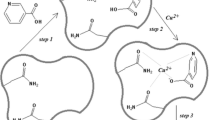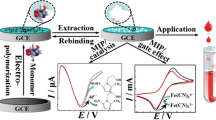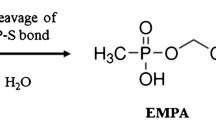Abstract
Pyruvic acid (PA) has been demonstrated to be an important cancer biomarker. Herein, carbon/carbon nanotube paste electrode was modified with the newly synthesized PA-imprinted polymer (MIP) and used as an enzyme-free sensor for PA assay. Methacrylic acid and ethylene glycol dimethacrylate were copolymerized in the presence of PA to prepare PA-IP. The MIP was characterized by scanning electron microscopy and Fourier transform infrared spectroscopy. To analyze PA by the MIP/CNT-CP electrode, the electrode was incubated in the PA solution for a constant time and then, the anodic differential pulse voltammetry signal was recorded. Both extraction and electrochemical determination solutions were the same, making the procedure simple and fast. Presence of the CNT in the MIP electrode led to a great enhancement in the PA signal. The MIP material not only pre-concentrated PA at the electrode surface but also increased the electron-exchange rate. This was confirmed by electrochemical impedance spectroscopy. The effects of electrode composition, extraction condition, and voltammetry parameters on the sensing efficiency were optimized. Dynamic linear range, detection limit, and RSD of the sensor were estimated to be 0.1–200 μM, 0.048 μM (S/N), and 3.6% (n = 3), respectively. The utility of the method was confirmed by appropriate analysis results obtained for the determination of PA in the plasma and urine samples.

Graphical Abstract






Similar content being viewed by others
References
Huang Y, Tian Y, Zhang Z, Peng C. A HILIC-MS/MS method for the simultaneous determination of seven organic acids in rat urine as biomarkers of exposure to realgar. J Chromatogr B. 2012;905:37–42.
Li Y, Ju X, Gao X, Zhao Y, Wu Y. Immobilization enzyme fluorescence capillary analysis for determination of lactic acid. Anal Chim Acta. 2008;610:249–56.
Chen P, Nie LH, Yao SZ. Determination of lactic acid and pyruvic acid in serum and cerebrospinal fluid by ion-exclusion chromatography with a bulk acoustic wave detector. J Chromatogr B. 1995;673:153–8.
Li Y, Chen J, Lun SY. Biotechnological production of pyruvic acid. Appl Microbiol Biotechnol. 2001;57:451–6.
Aimetti M, Cacciatore S, Graziano A, Tenori L. Metabonomic analysis of saliva reveals generalized chronic periodontitis signature. Metabolomics. 2012;8:465–74.
Smith MJH, Taylor KW. Blood pyruvate and α-ketoglutarate in normal and diabetic subjects. Br Med J. 1956;3:1035–8.
Stanko RT, Tietze DL, Arch JE. Body composition, energy utilization, and nitrogen metabolism with a 4.25-MJ/d low-energy diet supplemented with pyruvate. Am J Clin Nutr. 56:630–6.
Liao JC, Hoffman NE, Barborlak JJ, Roth DA. High-performance liquid chromatography of pyruvic and α-ketoglutaric acids and its application in urine sample. Clin Chem. 1977;23(5):802–5.
Magiera S, Baranowska I, Kusa J, Baranowski J. A liquid chromatography and tandem mass spectrometry method for the determination of potential biomarkers of cardiovascular disease. J Chromatogr B. 2013;919–920:20–9.
Makahleh A, Mohamed Ben-Hander G, Saad B. Determination of α-ketoglutaric and pyruvic acids in urine as potential biomarkers for diabetic II and liver cancer. Bioanalysis. 2015;7(6):713–23.
Hur H, Paik MJ, Xuan Y, Nguyen DT, Ham IH. Quantitative measurement of organic acids in tissues from gastric cancer patients indicates increased glucose metabolism in gastric cancer. PLoS One. 2014;9(6):e98581.
Bhat MA, Prasad KVV, Trivedi D, Rajeev BR, Battur H. Pyruvic acid levels in serum and saliva: a new course for oral cancer screening. J Oral Maxillofac Pathol. 2016;20:102–5.
Lee MS, Moon EJ, Lee SW, Kim MS, Kim KW, Kim YJ. Angiogenic activity of pyruvic acid in in vivo and in vitro angiogenesis models. Cancer Res. 2001;61:3290–3.
Berntsson S. Spectrophotometric determination of pyruvic acid by salicylaldehyde method. Anal Chem. 1955;27:1659–80.
Zhao YY, Gao XF, Li YS, Ju X, Zhang J, Zheng J. Determination of pyruvic acid by using enzymic fluorescence capillary analysis. Talanta. 2008;76:265–70.
Montanari L, Perretti G, Natella F, Guidi A, Fantozzi P. Organic and phenolic acids in beer. LWT—Food Sci Technol. 1999;32:535–9.
Zielinska D, Poels I, Pietraszkiewicz M, Radecki J, Geise HJ, Nagels LJ. Potentiometric detection of organic acids in liquid chromatography using polymeric liquid membrane electrodes incorporating macrocyclic hexaamines. J Chromatogr A. 2001;915:25–33.
Suarez MH, Rodriguez ER, Romero CD. Analysis of organic acid content in cultivars of tomato harvested in Tenerife. Eur Food Res Technol. 2008;226:423–35.
Ewaschuk JB, Naylor JM, Barabash WA, Zello GA. High-performance liquid chromatographic assay of lactic, pyruvic and acetic acids and lactic acid stereoisomers in calf feces, rumen fluid and urine. J Chromatogr B. 2004;850:347–51.
Rodrigues CI, Marta L, Maia R, Miranda M, Ribeirinho M, Máguas C. Application of solid-phase extraction to brewed coffee caffeine and organic acid determination by UV/HPLC. J Food Compos Anal. 2007;20:440–8.
Montenegro P, Valente IM, Gonçalves LM, Rodrigues JA, Barros AA. Single determination of α-ketoglutaric acid and pyruvic acid in beer by HPLC with UV detection. Anal Methods. 2011;3:1207–12.
Yoo KS, Pike LM. Determination of background pyruvic acid concentrations in onions, Allium species, and other vegetables. Sci Hortic. 2001;89:249–56.
Nakurte I, Keisa A, Rostoks N. Development and validation of a reversed-phase liquid chromatography method for the simultaneous determination of indole-3-acetic acid, indole-3-pyruvic acid, and abscisic acid in barley (Hordeum vulgare L.). J Anal Meth. 2012;2012:1–6.
Jin M, Dong Q, Dong R, Jin W. Direct electrochemical determination of pyruvate in human sweat by capillary zone electrophoresis. Electrophoresis. 2001;22:2793–6.
Klampfl CW, Buchberger W, Haddad PR. Determination of organic acids in food samples by capillary zone electrophoresis. J Chromatogr A. 2000;881:357–64.
Li W, Pan C, Hou T, Wang X, Li F. Selective and colorimetric detection of pyruvic acid using conformational switch of i-motif DNA and unmodified gold nanoparticles. Anal Methods. 2014;6:1645–9.
Rodrigues JEA, Erny GL, Barros AS, Esteves VI, Brandão T, Ferreira AA, et al. Quantification of organic acids in beer by nuclear magnetic resonance (NMR)-based methods. Anal Chim Acta. 2010;674:166–75.
Marcos P, Lué-Mer MP, Ricardo R, Mximo G, Maribel V, Luis BJ, et al. Pungency evaluation of onion cultivars from the Venezuelan West-Center region by flow injection analysis–UV–visible spectroscopy pyruvate determination. Talanta. 2004;64:1299–303.
Li X, Ling L, He Z, Song G, Lu S, Yuan L, et al. Development of a chemiluminescence method for the simultaneous determination of pyruvic and tartaric acids in human serum based upon their reaction with cerium (IV) in the presence of rutheniumtrispyridine. Microchem J. 2000;64:9–13.
Mizutani F, Yabuki S, Sato Y, Sawaguchi T, Iijima S. Amperometric determination of pyruvate, phosphate and urea using enzyme electrodes based on pyruvate oxidase-containing poly(vinyl alcohol)/polyion complex-bilayer membrane. Electrochim Acta. 2000;45:2945–52.
Situmorang M, Gooding JJ, Hibbert DB, Barnett D. The development of a pyruvate biosensor using electrodeposited polytyramine. Electroanalysis. 2002;14:17–21.
Ghica ME, Brett CMA. Development of novel glucose and pyruvate biosensors at poly(neutral red) modified carbon film electrodes. Application to Natural Samples. Electroanalysis. 2006;18:748–56.
Akyilmaz E, Yorganci E. Construction of an amperometric pyruvate oxidase enzyme electrode for determination of pyruvate and phosphate. Electrochim Acta. 2007;52:7972–7.
Martin C, Huser H, Servat K, Kokoh KB. Selective electroreduction of pyruvic acid on lead electrode in acid medium. Electrochim Acta. 2005;50:2431–5.
Wang J, Diao P. Direct electrochemical detection of pyruvic acid by cobalt oxyhydroxide modified indium tin oxide electrodes. Electrochim Acta. 2011;56:10159–65.
Brahman PK, Pandey N, Topkaya SN, Singhai R. Fullerene–C60–MWCNT composite film based ultrasensitive electrochemical sensing platform for the trace analysis of pyruvic acid in biological fluids. Talanta. 2015;134:554–9.
Alizadeh T, Mirzagholipur S. A Nafion-free non-enzymatic amperometric glucose sensor based on copper oxide nanoparticles–graphene nanocomposite. Sensors Actuators B Chem. 2014;198:438–47.
Prodromidis MI, Tzouwara-Karayanni SM, Karayannis MI, Vadgama PM. Bioelectrochemical determination of citric acid in real samples using a fully automated flow injection manifold. Analyst. 1997;122:1101–6.
Alizadeh T, Hamidi N, Ganjali MR, Nourozi P. Development of a highly selective and sensitive electrochemical sensor for Bi3+ determination based on nano-structured bismuth-imprinted polymer modified carbon/carbon nanotube paste electrode. Sensors Actuators B Chem. 2017;245:605–14.
Alizadeh T, Amjadi S. Indirect voltammetric determination of nicotinic acid by using a graphite paste electrode modified with reduced graphene oxide and a molecularly imprinted polymer. Microchim Acta. 2017;184:2687–95.
Hsu SC, Cheng HT, Wu PX, Weng CJ, Santiago KS, Yeh JM. Electrochemical sensor constructed using a carbon paste electrode modified with mesoporous silica encapsulating PANI chains decorated with GNPs for detection of ascorbic acid. Electrochim Acta. 2017;238:246–56.
Alizadeh T, Ganjali MR, Rafiei F. Trace level and highly selective determination of urea in various real samples based upon voltammetric analysis of diacetylmonoxime-urea reaction product on the carbon nanotube/carbon paste electrode. Anal Chim Acta. 2017;974:54–62.
Alizadeh T, Ganjali MR, Akhoundian M. Fabrication of an extra sensitive voltammetric sensor using nanoparticles of molecularly imprinted polymer for determination of ultra-trace promethazine in plasma sample. Int J Electrochem Sci. 2012;7:10427–41.
Uzun L, Turner APF. Molecularly-imprinted polymer sensors: realizing their potential. Biosens Bioelectron. 2016;76:131–44.
Ashley J, Shahbazi MA, Kant K, Chidambar VA, Wolff A, Bang DD, et al. Molecularly imprinted polymers for sample preparation and biosensing in food analysis: progress and perspectives. Biosens Bioelectron. 2017;91:606–15.
Wackerlig J, Lieberzeit PA. Molecularly imprinted polymer nanoparticles in chemical sensing – synthesis, characterisation and application. Sensors Actuators B Chem. 2015;207:144–57.
Alizadeh T, Amjadi S. Indirect voltammetric determination of nicotinic acid by using a graphite paste electrode modified with reduced graphene oxide and a molecularly imprinted polymer. Microchim Acta. 2017;184:2687–95.
Alizadeh T, Azizi S. Graphene/graphite paste electrode incorporated with molecularly imprinted polymer nanoparticles as a novel sensor for differential pulse voltammetry determination of fluoxetine. Biosens Bioelectron. 2016;81:198–206.
Author information
Authors and Affiliations
Corresponding author
Ethics declarations
Conflict of interest
The authors declare that they have no conflict of interest.
Additional information
Publisher’s note
Springer Nature remains neutral with regard to jurisdictional claims in published maps and institutional affiliations.
Electronic supplementary material
ESM 1
(DOCX 58 kb)
Rights and permissions
About this article
Cite this article
Alizadeh, T., Nayeri, S. An enzyme-free sensing platform based on molecularly imprinted polymer/MWCNT composite for sub-micromolar-level determination of pyruvic acid as a cancer biomarker. Anal Bioanal Chem 412, 657–667 (2020). https://doi.org/10.1007/s00216-019-02273-4
Received:
Revised:
Accepted:
Published:
Issue Date:
DOI: https://doi.org/10.1007/s00216-019-02273-4




